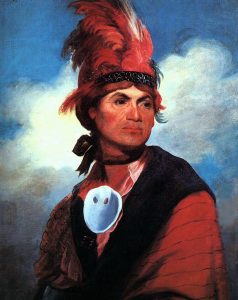"What, here? Really?" Finding Native Americans in the Royal Archives
Harrison Cutler, a third-year undergraduate student in History at King’s College London, reports on his project “Marginalised Indians: Native Americans in British Archives, 1763 to 1795” (supervisor: Dr Angel-Luke O’Donnell), as part of the King’s Undergraduate Research Fellowship scheme.
“What, here? Really?” – the potential difficulty of finding Georgian sources on Native Americans was encapsulated succinctly by a fellow researcher upon a visit to the Royal Archives at Windsor. Nevertheless, over the course of July and August 2016 I was able to accumulate two vast bibliographies of both pamphlets and books regarding Native American peoples from the library catalogues of George III located in the British Library.

Portrait of Thayendanegea (Joseph Brant) by Gilbert Stuart, 1786.
Before embarking on upon the Library reading rooms, Dr. O’Donnell and I discussed potentially illuminating themes and terms via which Native American sources might be found within the late eighteenth and early nineteenth century context. That George himself was such a keen naturalist suggested environmental texts might be fruitful. The French and Indian War, which culminated in the Royal Proclamation of 1763 (restricting colonial settlement to east of the Appalachians), as well as the American War of Independence highlighted that texts pertaining to warfare might be useful considering the significance of Native Americans in these military engagements. I was also wary of significant figures in colonial relations with Native Americans, including Indian Agent Sir William Johnson, whose regular relations with Native Americans would inform any authored works. These themes, amongst others, provided the starting point for beginning the databases.
The crucial source for these bibliographies were the unpublished Catalogue of King’s Pamphlets (9 vol., 1850s, L.R.419.b.3) and F. A. Barnard’s Bibliotechae Regiae Catalogus (10 vol., 1820, RAC Rare Books and Music Reading Room), which exhaustively detailed the contents of the King’s Library. Whilst systematically poring through each volume, I produced two longlists, each containing c. 500 potential sources by applying the selection criteria pre-established, which was continually broadened as I grew better accustomed to the nature of the respective collections.
From the catalogues, I noted the shelf reference, the author or reference name, the title, size, location and date of publishing, as well as the edition of the print. Taking down all of this information enabled me to further reduce the longlists I had created using the Eighteenth Century Collections Online (ECCO), a fully digitised database of over 180,000 books, pamphlets and much beyond. Since these documents are fully text-searchable, having found each of the documents from my longlists I used a series of key terms to identify whether Native Americans appeared therein.
Using the terms ‘Indian*’, ‘Tribe*’, ‘Native*’, ‘Savage*’, ‘Iroquois*’, ‘Mohawk*’, and ‘Cherokee*’, with the asterisk serving to broaden the search to similar terms or derivations, I was able to roughly quantify the preponderance, or absence, of Native Americans in each of the sources. Consequently, I reduced the longlist to a shortlist, ordered by the number of my key terms that appeared within each, taking the assumption that the greatest number of references would provide the best starting point for further investigation
This process was completed in full for the pamphlet database, taken from the Catalogue of King’s Pamphlets, which was the first task I undertook on my project. From a Catalogue of around 19,000 titles, I noted 673 titles, which produced 234 titles which struck at least one of my keywords. As Dr. O’ Donnell and I had predicted, the books database longlist was smaller, at only 310 titles. The mentioned process of reducing this to a shortlist is ongoing.
Overall, this was an extremely valuable experience for me to engage in broader academic investigation beyond my degree at King’s. I am very grateful for the support of Dr. O’Donnell, as well as manifold others including the staff at the Royal Archives for their invaluable tips into making the best of any archival visit. It has been fantastic to bear witness to the display of the Georgian Papers Programme at King’s, and I look forward to maintaining an eye on the progress of the project.
